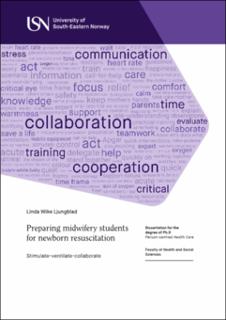| dc.contributor.author | Ljungblad, Linda Wike | |
| dc.date.accessioned | 2023-12-05T07:37:59Z | |
| dc.date.available | 2023-12-05T07:37:59Z | |
| dc.date.issued | 2023 | |
| dc.identifier.isbn | 978-82-7206-809-6 | |
| dc.identifier.issn | 2535-5252 | |
| dc.identifier.uri | https://hdl.handle.net/11250/3105906 | |
| dc.description.abstract | Background:
Between 4 and 10% of all newborn babies need support to start breathing immediately after birth. Midwives are the professionals who attend most deliveries in Norway. Hence, they are the ones who most frequently identify the need for and initiate newborn resuscitation within a short time interval, globally referred to as "the golden minute". However, recent studies have identified challenges when it comes to adhering to guidelines related to “the golden minute”, such as difficulty completing all tasks within the allocated timeframe. Despite the existence of several training programmes in newborn resuscitation, few studies focus exclusively on how midwifery students in particular can best prepare for newborn resuscitation. Such a course should incorporate the experiences of midwives in relevant clinical practice.
Aim:
The overall aim of this study was to explore midwives' experiences in newborn resuscitation and develop a newborn resuscitation course tailored for midwifery students. Methods: Three qualitative studies with explorative design were conducted, each addressing a specific aim and presented in its own paper. The data was collected between August 2018 and October 2020. Midwives and midwifery students from across Norway were included as participants. Study 1 consisted of in-depth interviews of 16 midwives from across Norway, who answered one open-ended question about their experiences performing newborn resuscitation. A phenomenological hermeneutical approach was chosen for the analysis. In study 2, semi-structured interviews were conducted with 16 midwives about their experiences and suggestions for the content and structure of a course in newborn resuscitation for midwifery students. Systematic text condensation was chosen as a method for analysing the data. In study 3, co-creation in workshops was chosen to develop a newborn resuscitation course tailored to midwifery students. In total, eight midwives and twelve midwifery students participated in four workshops. Data were analysed using a framework method.
Findings:
This thesis found midwives' role in newborn resuscitation to be complex, involving multiple challenges simultaneously within a short time interval. Midwives shared ideas for content and structure for a course in newborn resuscitation for midwifery students based on their experiences and developed a course in co-creation with midwifery students. This course is proposed to be used in a lifelong learning process in which continuous competencies can be reassumed in clinical practice as a continuum throughout a midwife’s career. Various innovative methods are presented to meet midwifery students' individual learning needs. The importance of a safe learning environment where emotional reactions are acknowledged and valued is emphasised. Preparedness related to a midwifery focus is carefully considered for midwifery students to identify the need for and initiate required assessments in newborn resuscitation within a short time interval. The findings are presented in the form of a model for preparing midwifery students for newborn resuscitation.
Conclusion:
The findings guided the further development of the proposed newborn resuscitation course. The course outlines how to achieve essential midwifery competencies in newborn resuscitation through suggested learning outcomes and learning activities. A midwifery focus is emphasised. This thesis proposes that preparing midwifery students for newborn resuscitation in their clinical practice entails a lifelong learning process that begins with midwifery education in a safe culture where emotional reactions are acknowledged. | en_US |
| dc.language.iso | eng | en_US |
| dc.publisher | University of South-Eastern Norway | en_US |
| dc.relation.ispartofseries | Doctoral dissertations at the University of South-Eastern Norway;176 | |
| dc.relation.haspart | Paper 1 Ljungblad, L. W., Skovdahl, K., McCormack, B., & Dahl, B. (2020). Balancing Life and Death During the Golden Minute - Midwives' Experiences of Performing Newborn Resuscitation. Journal of Multidisciplinary Healthcare, 13, 943-952. https://doi.org/10.2147/jmdh.S268959 | en_US |
| dc.relation.haspart | Paper 2 Ljungblad, L. W., Skovdahl, K., McCormack, B., & Dahl, B. (2021). An exploration of midwives' perceptions of newborn resuscitation programmes for midwifery students. Midwifery, 100, 103021. https://doi.org/10.1016/j.midw.2021.103021 | en_US |
| dc.relation.haspart | Paper 3 Ljungblad, L. W., Skovdahl, K., McCormack, B., & Dahl, B. (2022). "Keep It Simple"-Co- Creation of a Tailored Newborn Resuscitation Course for Midwifery Students. Advances in medical education and practice, 13, 81-93. https://doi.org/10.2147/AMEP.S346991 | en_US |
| dc.rights.uri | http://creativecommons.org/licenses/by-nc-sa/4.0/deed.en | |
| dc.subject | gjenoppliving av nyfødte | en_US |
| dc.subject | golden minute | en_US |
| dc.subject | jordmorfag | en_US |
| dc.subject | jordmorstudenter | en_US |
| dc.subject | stimuleringstrening | en_US |
| dc.title | Preparing midwifery students for newborn resuscitation: Stimulate-ventilate-collaborate | en_US |
| dc.type | Doctoral thesis | en_US |
| dc.description.version | publishedVersion | en_US |
| dc.rights.holder | (c) Copyright: The author | en_US |
| dc.subject.nsi | VDP::Medisinske Fag: 700 | en_US |
| dc.source.pagenumber | 189 | en_US |

